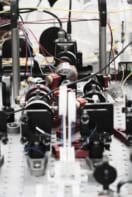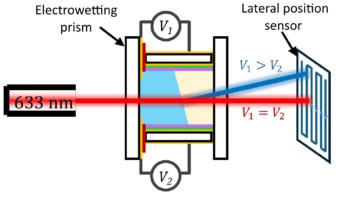In this International Year of Light (IYL 2015) we don’t just want to tell you about how great light and its applications are, we want to show you too. So in this short video, industrial scientist and outreach enthusiast Neil Downie demonstrates the phenomenon of strong focusing using nothing more than a basic laser and some cheap magnifying glasses he bought on the high street. It is a demonstration that you could easily replicate – either for your students or just for your own amusement.
In the first part of the demonstration, Downie shows how light can be transmitted to a point straight in front of the laser, even when it has to pass through a series of magnifying glasses that are aligned slightly off-axis. You can see how the light wiggles its way along the line of magnifying glasses, with its deflections appearing to be “corrected” as the light is focused on the centre of each lens. It is a similar effect to that found in particle accelerators where electromagnetic lenses are used to focus beams of charged particles.
In the second part of the demo, Downie uses the same equipment to show how light can be bent around an arc. This time, rather than the strong focusing effect, instead he is using the fact that light is deflected as the beam passes through the edges of each of the lens. It is the combination of strong focusing and deflection that enables particles to be accelerated to high speeds while remaining focused at particles accelerators such as CERN’s Large Hadron Collider (LHC).
Downie is the author of The Ultimate Book of Saturday Science, in which he collects a selection of his favourite science demonstrations that he has presented at a long-running Saturday-morning science club for high-school students in the UK. He is the author of a feature article that will appear in the upcoming April issue of Physics World, in which he provides instructions for five other quirky demonstrations, including a “vacuum bazooka” and a “ball river bobsleigh”. The digital edition of that issue will feature videos of each demonstration for you to enjoy.
If you want to enjoy more light-related content, then the March issue of Physics World is a special issue devoted to light and light-based technology to mark IYL 2015. If you’re a member of the Institute of Physics (IOP), you can enjoy access to new issues as soon as they are available with the digital edition of the magazine on your desktop via MyIOP.org or on any iOS or Android smartphone or tablet via the Physics World app, available from the App Store and Google Play. If you’re not yet in the IOP, you can join as an IOPimember for just £15, €20 or $25 a year to get full access to Physics World both online and through the apps.



